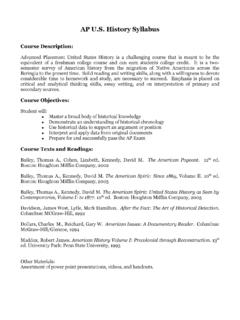Transcription of AP ART HISTORY 2015-2016 1 AP ART HISTORY IMAGE SET ...
1 AP ART HISTORY 2015-2016 1. AP ART HISTORY IMAGE SET snapshot #1. IMAGE SET identification: Apollo 11 stones. Namibia. c. 25,500-25,300 E. Charcoal on stone. snapshot : This pre-historic charcoal drawing of an unknown animal is one of the oldest known artworks that originated from the African continent. At the time of its creation it would have been considered nothing more than a drawing, but today this collection of drawings is some of the first evidence we have of early human communication. These stones originate from the Apollo 11 caves in Namibia and were likely meant to illustrate the game that could be found in the region at that time. It is unclear if there is a story being told by the drawings but it is probable that they all display a continuity that could be understood by the people in the region during the time frame of their creation and could be used to communicate some idea.
2 Through very precise carbon dating, these drawings are able to give scientists a timeframe of when changes in human behavior occurred and when social and biological evolution was happening among the human race, as well as show us where humanity's first hunter and gatherer societies began. This ancient art was what the humans of its day used to communicate with each other and would seem very insignificant at the time, but in today's society this piece lets us study more about humanity's humble beginnings. AP ART HISTORY 2015-2016 2. AP ART HISTORY IMAGE SET snapshot #1. Possible Themes: Reverence of Nature, Hunting Possible Subthemes: Animal qualities, Communication Possible Connections with other works in the IMAGE SET: Running Horned Woman.
3 Tassili n'. Ajjer, Algeria. 6000-4000 B. C. E. Pigment on rock. This work is also a drawing possibly meant for communication or storytelling. Camelid sacrum in the shape of a canine. Tequixquiac, central Mexico. 14,000- 7000 B. C. E. Bone. This work is also meant to represent an animal from the region the piece comes from. Resources: YouTube video: Article on the drawings: Article on the drawings: Article on the time period: AP ART HISTORY 2015-2016 3. AP ART HISTORY IMAGE SET snapshot #1. Khamaria Shanks &. IMAGE set: Apollo 11 stones. Namibia. 25,500-25,300 Charcoal on stone. There are a total of seven slabs that were found in the Apollo 11 cave in the mountains of southwestern Namibia. These stones are the oldest scientifically dated rock art in African HISTORY .
4 The stones were made of grey-brown quartzite, and the drawings were done with charcoal. The stones are engraved with geometric lines and representations of animals. The cave was named after the Apollo 11 spaceship in 1969, by the German archaeologist Dr. Wolfgang Eric Wendt He was researching the area known as the Goachanas by the locals. The stones are 5 x4 with drawings of animals that aren't very easy to identify but, have been interpreted as felines. There are some that have been identified as a Zebra, Ostrich, or a Giraffe. It is said that these slabs were not from the cave walls of Apollo 11; they were brought from somewhere else. There isn't any hard evidence showing that, that is the case. Possible Themes: natural world, and belief Possible Subthemes: Life, private/public Resoursces: Khan Academy: ap/paleolithic-mesolithic-neolithic/a/ap ollo-11-stones British Museum website: _project/ AP ART HISTORY 2015-2016 4.
5 IMAGE SET Identification: Camelid sacrum in the shape of a canine. Tequixquiac, Central Mexico. Unknown Artist. 14,000-7,000 BCE. Bone. snapshot : Created before the establishment of the Mayan or Aztec Empire, the Camelid sacrum in the shape of a canine is thought to have been originally intended as a mask used in the religious ceremonies of the Mesoamericans. Though the artist is unknown, scholars have gathered enough information from similar prehistoric cultures to speculate that the mask was probably used specifically for fertility ceremonies. The bone from which it was carved, the sacrum, is found in the lower back between the hip bones of the pelvis; according to the ancient Egyptians, because of its position at the end of the spine, the sacrum was like a spiritual head, and a link to the afterlife; in addition, there was a long lasting belief upheld by many cultures that the sacrum played a significant part in reproduction.
6 The camelid was an American relative to the camel; it is now extinct, but it was a major staple in the diet of the Mesoamericans. They would try to use every part of the animal, including the bones. The canine was chosen as a symbol of fertility likely because of its natural ability as a hunter, and their way of life was centered on hunting and gathering. It is important to mention, that the mask not only served as a symbol to those who participated in or witnessed the ceremony, but was also believed to have AP ART HISTORY 2015-2016 5. been inhabited by an animal spirit. It was held that the spirit would enhance the wearer's abilities. Because of the time of its creation, this canine mask is a somewhat solitary case that gives a look into the religious beliefs and practices of the Mesoamericans, especially pertaining to life, fertility, and the afterlife.
7 Possible Themes: Connections between cultures and people, multiple parts that make a whole, religious beliefs and culture Possible Subthemes: Life Cycles, religious ceremonies, humanity and nature with god Resources: Camelid sacrum in the shape of a canine flashcard: Class website: Khan Academy Video: AP ART HISTORY 2015-2016 6. AP ART HISTORY IMAGE SET snapshot #4. IMAGE SET full ID: Running Horned Woman. Tassili n'Ajjer, Alergia. 6000-4000 Rock Painting IMAGE : snapshot : The Running horned woman is a cave painting in Tassili n'Ajjer, Algeria. It was found in 1928, and was created by the Nok people between 6000-4000 It was painted in a time period when the art was mostly for communication and depicted climate change, animal migration, and human evolution.
8 It depicts a large woman with horns on her head running; her size and position give the assumption that she is most important. The horns on her head are believed to sybolize power. The background depicts smaller figures, some with out heads, leading us to believe they are lesser to her. They all appear to be running in the same direction, and it seems as if the woman is leading them. Scholars have speculated it is representing a relgious ceremony, and convey's themes of faith and unity amoung the people and their God. This unity is shown through the people running with their God and trusting her to show them the way. Over time, though, the meaning trying to be conveyed has likely been changed because there is no writing telling us exactly what the picture means.
9 The artist used rocks as their canvas and natural paints, because there was nothing else they could've used. The pigments were extracted for ochreous schist and they used many engraving techniques. Its signaficant because it shows that these people were intelligent to invent paint and use this art as a form of communication. AP ART HISTORY 2015-2016 7. AP ART HISTORY IMAGE SET snapshot #4. snapshot continued (if needed).. Possible subthemes: Tribal Culture, Humanity Possible connections with other works in the IMAGE SET: 2. Great Hall of the Bulls. Lascaux, France, Paleothlic Europe. 15,000-13,000 Rock Painting. This work was painted with the same materials even though its in a different part of the world. Resources: Khan Acadamy: UNESCO: AP ART HISTORY 2015-2016 8.
10 AP ART HISTORY IMAGE SET snapshot #5. IMAGE SET Identification: Beaker with ibex motifs. Susa, Iran. 4200-3500 Painted terra cotta. snapshot : Supposedly created around the Neolithic era, this ambiguously marked bushel is unknown in many aspects other than its use of burying the dead. Due to its thin structure, the vessel was not built for regular usage, but rather, ceremony and ritual, which makes sense due to the precedent of practical workmanship. The beaker's most defining point is notably the mountain goat. The goat's design comes down to merely triangles, but the details of its beard and tail are still clear with its accentuated horns encircling the ibex. Many speculate the ibex is a symbol of a specific clan within the Susa society, which one could infer allowed the society to preserve their selves into the afterlife.








